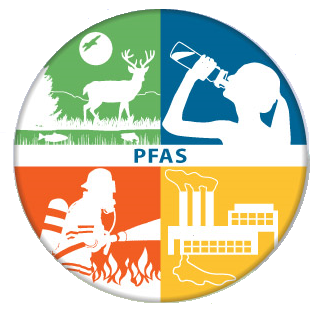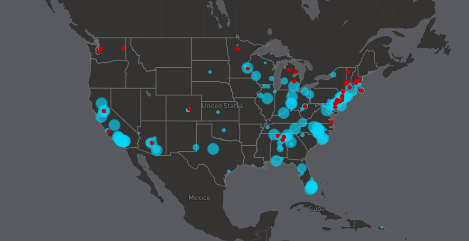GBA Emerging Contaminants Spotlight – PFAs
 Per- and Poly-fluorinated alkyl substances (PFAs) concerns in the environment are one of the hottest emerging environmental topics in the country. The compounds, developed in the 1950’s, have been used in a wide variety of everyday products including paper and plastics, water resistant fabrics coatings such as Gore-tex, non-stick coatings including Teflon, paper and packaging products, and stain resistant carpet and fabric coatings. Along with the processes and facilities responsible for the production of the goods, as the final repository for societal waste, PFAs are increasingly showing up in landfill leachate as the leaching process takes place within the landfill mass.
Per- and Poly-fluorinated alkyl substances (PFAs) concerns in the environment are one of the hottest emerging environmental topics in the country. The compounds, developed in the 1950’s, have been used in a wide variety of everyday products including paper and plastics, water resistant fabrics coatings such as Gore-tex, non-stick coatings including Teflon, paper and packaging products, and stain resistant carpet and fabric coatings. Along with the processes and facilities responsible for the production of the goods, as the final repository for societal waste, PFAs are increasingly showing up in landfill leachate as the leaching process takes place within the landfill mass.
In the past 20+ years, an extremely effective class of flame  suppressants, commonly referred to aqueous fire-fighting foam (AFFF), have been extensively used to contain fires at fuel refineries,industrial complexes, airports, and fire training facilities. Developed prior to the increasing concern of potential adverse health effects of PFAs and phased out both in the US and globally, AFFF is a significant source of PFAs.
suppressants, commonly referred to aqueous fire-fighting foam (AFFF), have been extensively used to contain fires at fuel refineries,industrial complexes, airports, and fire training facilities. Developed prior to the increasing concern of potential adverse health effects of PFAs and phased out both in the US and globally, AFFF is a significant source of PFAs.
With emerging concerns regarding human health risk and the increasing discovery of PFA-impacts in the soil, groundwater and surface water, in 2016 EPA issued a “non-binding” human health lifetime advisory level of 70 parts per trillion (ppt) as a threshold value. With increasing national concern and lack of toxicity research, the EPA held a National PFAs Summit in May 2018 with the state health agency points of contact and other invited agencies. The purpose of the summit was to develop a plan to address the PFAs issue from a federal level. Specific PFA compounds discussed in the summit meeting include perfluorooctanoic acid (PFOA), perfluorooctane sulfonic acid (PFOS), and perfluorobutane sulfonic acid (PFBS). A summary of the discussion can be found here: (https://www.epa.gov/pfas/pfas-national-leadership-summit-and-engagement).
According to the Environmental Council of States (ECOS) representing the collective states, four action items came out of the Summit:
- “EPA will initiate steps to evaluate the need for a maximum contaminant level (MCL) for PFOA and PFOS.
- EPA is beginning the necessary steps to propose designating PFOA and PFOS as ‘hazardous substances’ through one of the available statutory mechanisms, including potentially CERCLA Section 102.
- EPA is currently developing groundwater cleanup recommendations for PFOA and PFOS at contaminated sites and will complete this task by fall of this year.
- EPA is taking action in close collaboration with our federal and state partners to develop toxicity values for GenX and PFBS.”
While the EPA has been accelerating the process of evaluating PFAs on a federal level, some states such as New Jersey, have set “state health advisory guidelines” that are lower than the EPA 70 ppt threshold. As recent as last week, California took the first step to establishing a state Maximum Contaminant Level (MCL) in drinking water of 14/13 ppt for 2 specific PFAs compounds most often found. New Hampshire has adopted a statewide testing program for water supplies as have most other states.
 Assessing the water supplies is a specialized process since the laboratory detection levels are looking at ppt levels Parts per trillion can be equated to a drop of water in the volume of a large scale supermarket warehouse! At these detection levels, particular caution needs to be taken to not introduce contamination from surfaces that could contain PFAs such as treated clothing, plastic containers, etc.
Assessing the water supplies is a specialized process since the laboratory detection levels are looking at ppt levels Parts per trillion can be equated to a drop of water in the volume of a large scale supermarket warehouse! At these detection levels, particular caution needs to be taken to not introduce contamination from surfaces that could contain PFAs such as treated clothing, plastic containers, etc.
The expanding PFAs concern will continue to present opportunities in the environmental areas of due diligence in property transactions, assessment and remediation of impacted sites, and consulting regarding client risk identification and mitigation. Regarding deep foundation construction such as drilled shaft piers (caissons), impacted soil and groundwater containing PFAs will require special management.
The Interstate Technology and Regulatory Council (ITRC) is a state-lead private-public coalition dedicated to advancing the study of environmental solutions. They currently have a PFAs Team dedicated to developing technical guidance documents to provide a platform for better understanding PFAs assessment and management. More information regarding PFAs can be found on their website such as 7 fact sheets including AFFF, an introductory document, and acronym list. A link to the website can be found here: https://pfas-1.itrcweb.org/ . A final Tech Reg document is anticipated by late 2018 early 2019.
*Note: All images courtesy of the internet.